
Master of Disaster, Ignatius Donnelly
The destruction of Atlantis, cataclysmic comets, and a Manhattan tower made entirely from concrete and corpse — Carl Abbott on the life and work of a Minnesotan writer, and failed politician, with a mind primed for catastrophe.
September 27, 2017
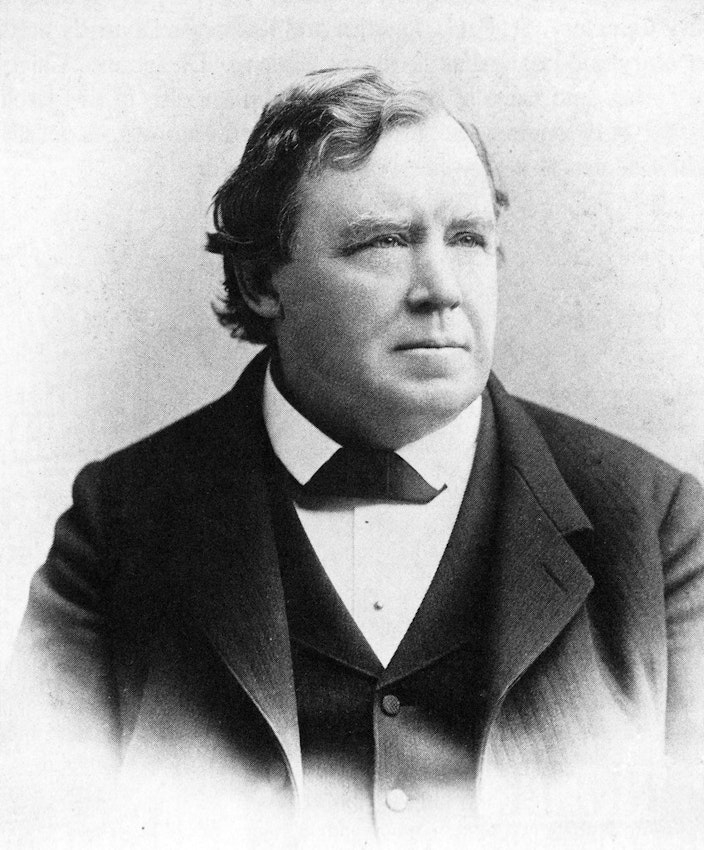 Scroll through the whole page to download all images before printing.
Scroll through the whole page to download all images before printing.Ignatius Donnelly, ca. 1880 — Source.
The magnificent civilization of Atlantis shattered and plunged beneath the sea in February 1882. Or, to be more precise, the eccentric American Ignatius Donnelly published Atlantis: The Antediluvian World, the first book of a trio that would highlight a series of imaginary catastrophes. The book — a rehash of Atlantis speculation supported with flood myths from around the globe — was an instant success and has continued to draw readers over the decades. Newspaper reviews were laudatory: Harper and Brothers issued seven printings in the first year, and W. E. Gladstone took time out from pondering the Irish Question to write Donnelly a four-page fan letter.
It was easy to imagine the worst in 1882. President James Garfield had been assassinated only months earlier — the second president shot to death in sixteen years. The economy was dropping into a new recession even as it struggled to emerge from the dark years of the 1870s. Farmers in Donnelly’s state of Minnesota were especially hard hit. In September, thirty thousand New York workers marched in the nation’s first Labor Day parade, remembering the violent railroad strike of five years earlier.
Atlantis might have seemed to offer relief from the turmoil. Its densely packed pages of pseudoscience and mythology recounted the supposed golden age of the lost continent and world-spanning civilization first mentioned by Plato. But the subtext was the fragility of a golden age. When Atlantis sank beneath the waves in a global cataclysm, a powerful and nearly perfect society perished. For Donnelly, Atlantis was a model and mirror for the United States, where urbanization, industrialization, and the accumulation of vast wealth were a social deluge destroying the nation’s own golden age of the agrarian frontier.
It was personal. That mythicized American frontier had promised much to Donnelly and delivered less. He began as an enthusiast who tried to make it as a farmer, land developer, and politician in a nation that seemed to offer unlimited opportunity but was riven by social and economic conflicts. He was also a prickly character. He started out as a lawyer in Philadelphia, but quarrels with clients and family propelled him to Minnesota in 1858, just as it was being admitted as a state. He plunged into land speculation and politics. Nininger City, an undeveloped townsite seventeen miles from St Paul needed only his promotional talents to become a major river port and make Donnelly a rich man, or so he hoped. Alas, few residents came. Readers of Charles Dickens might think of Martin Chuzzlewit’s ill-fated visit to Eden, another Mississippi Valley “city” that never matched its press notices.
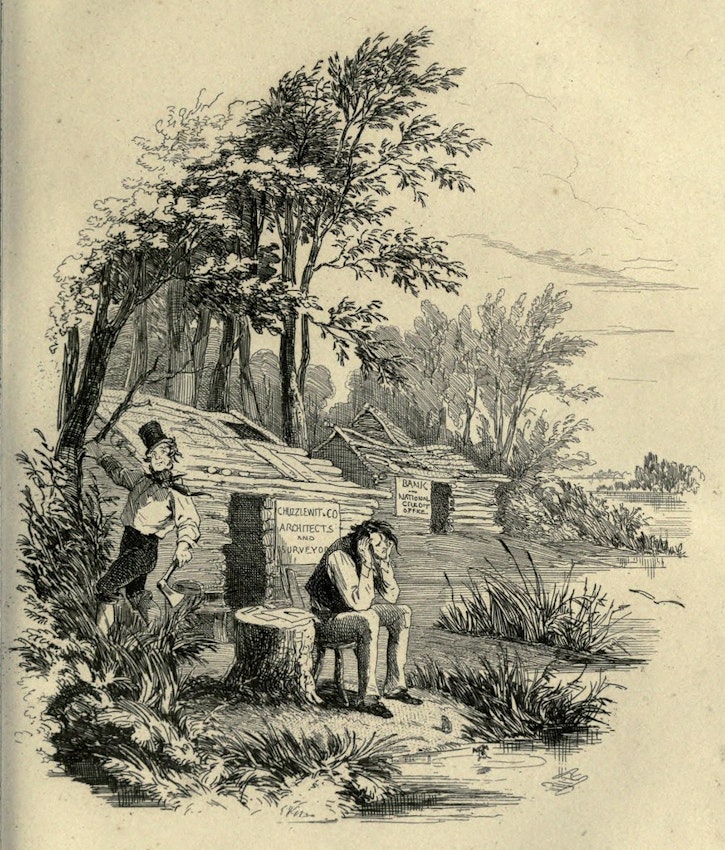 Scroll through the whole page to download all images before printing.
Scroll through the whole page to download all images before printing.“The Thriving City of Eden as It Appeared in Fact”, illustration by Phiz for Charles Dickens’ Martin Chuzzlewit (1859) — Source.
Undeterred, Donnelly got in with the new Republican Party and was elected Lieutenant Governor of Minnesota at age twenty-eight: he then served as US Congressman for three terms from 1863–68. Not a man to hold his tongue, however, he split with Republicans because they were becoming conservative, returned to his lonely mansion at Nininger, ran an anti-monopoly newspaper, and tried out a series of third parties and splinter factions, which failed to propel him to the offices he thought he deserved.
Twenty years of personal frustration turned his thoughts toward catastrophe. Reporting on the Dakota War of 1862, in which Sioux tribes struck back at encroaching settlers in western Minnesota, he had seemed to revel in the horrors of war. For a St Paul newspaper he described refugees from the town of New Ulm: “There were mothers there who wept over children slaughtered before their eyes, strong men . . . who had escaped into the grass with the death shrieks of parents, brothers, and sisters, ringing in their ears.”
Those death shrieks were just the start for a writer who came to specialize in cataclysms that could rend entire cities, ravage entire civilizations, or destroy entire continents. As his ambitions and plans repeatedly fell short — his agrarian golden age failed to materialize — he took up his pen to explore increasingly extreme visions of apocalypse. First came “factual” accounts of two very different prehistoric disasters — Atlantis (1882), followed by Ragnarok: The Age of Fire and Gravel (1883) — and then, seven years later, Caesar’s Column: A Story of the Twentieth Century (1890), a futuristic novel that major publishers rejected as dangerously revolutionary.
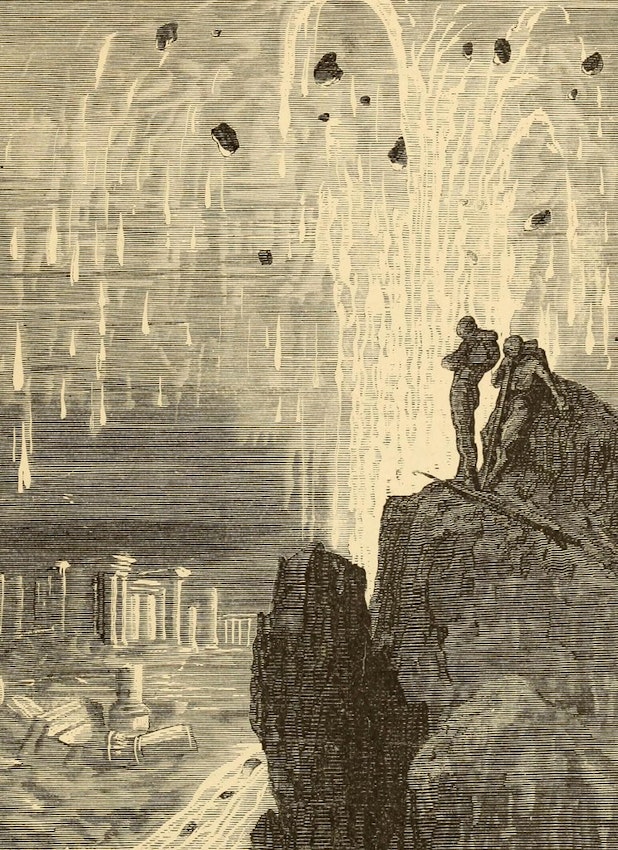 Scroll through the whole page to download all images before printing.
Scroll through the whole page to download all images before printing.“There, under my eyes, destroyed, ruined, lay a town”, illustration by Alphonse de Neuville depicting Captain Nemo’s discovery of Atlantis, in Jules Verne’s Twenty Thousand Leagues Under the Sea (1875) — Source.
The description of disaster in Atlantis was relatively low-keyed. Donnelly did not bother to recreate the catastrophe in his own words because he could cite deluge myths and legends from all over the world.
An event, which in a few hours destroyed, amid horrible convulsions, an entire country, with all its vast population — that population the ancestors of the great races of both continents, and they themselves the custodians of the civilization of their age — could not fail to impress with terrible force the minds of men, and to project its gloomy shadow over all human history. And hence, whether we turn to the Hebrews, the Aryans, the Phœnicians, the Greeks, the Cushites, or the inhabitants of America, we find everywhere traditions of the Deluge; and we shall see that all these traditions point unmistakably to the destruction of Atlantis.
In Ragnarok Donnelly went extraterrestrial. The book shows a cataclysmic mind at work, with its core assumption that change comes via revolution, upheaval, and calamity. In Atlantis he had riffed on a well-known story. Now he invented his very own cataclysm. Louis Agassiz, Charles Lyell, and other geologists had been replacing a catastrophe-driven history of Earth with gradual processes, but Ignatius Donnelly was having none of that. Churning out four-hundred-fifty pages in seven weeks (rewriting was not his thing), he described a supposed cosmic disaster in which a comet grazed Earth, showering it with “the Drift”, his name for the layer of sand, gravel, and soil that lies over our planet’s bedrock.
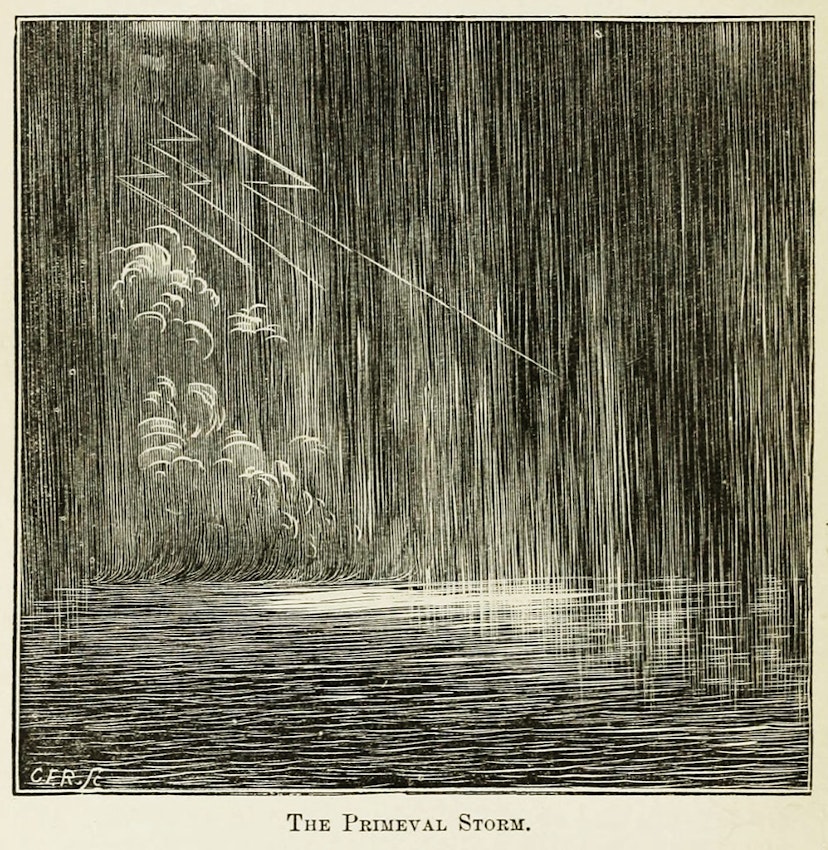 Scroll through the whole page to download all images before printing.
Scroll through the whole page to download all images before printing.One of the many illustrations featured in Ragnarok: The Age of Fire and Gravel (1883) — Source.
Atlantis had been a financial success, throwing off enough income to encourage more writing. Ragnarok was a different story. It started off well, but sales crashed after a few weeks and its author grew frustrated with New York’s literary and scientific establishments (his publisher failed to push the second book; scientists ignored or ridiculed the cometary catastrophe). E. L. Youmans, the editor of Popular Science Monthly and the nation’s most influential science journalist, called Ragnarok “absurd” (although it may have influenced the similarly crackpot thesis of Immanuel Velikovsky in Worlds in Collision in 1950). It didn’t help that this man of the prairies not only found the New York literary establishment unhelpful but thought New York itself an unpleasant place, calling out its “endless roar and hurry” and “seething whirlpool of struggling humanity”.
Donnelly tried to fight back, damning the arbiters of American science as pedantic schoolmasters who parroted the orthodoxy of European experts rather than look to new creative ideas. “Neither will an American Scientist accept any American thought until it has the brand of foreign approval”, he lamented in his diary. A third book that claimed to find cryptograms by Francis Bacon hidden within Shakespeare’s Henry IV met another chilly reception (“mountebank” was one reviewer’s judgment on the author). “My book is a failure, and my political prospects are dark”, he grieved in July 1888. A few months later he let his manic side loose: he ran for governor of Minnesota but dropped out part way through the campaign, lost an election to the state legislature that was supposed to be a sure thing, and put his name forth as a sadly hopeless candidate for US Senate.
The day after his senatorial bid failed, Donnelly began work on his second bestseller. He had ended Ragnarok with a tacked-on assault on the evils of capitalism and its tacit belief that “heaven is only a larger Wall Street, where the millionaires occupy the front benches”. Caesar’s Column, which appeared in April 1890 from an obscure Chicago publisher after New York houses wouldn’t touch it, took the ills of capitalism head-on. It sold an impressive sixty thousand copies in nine months, gained three English editions, and was translated into German, Swedish, and Norwegian.
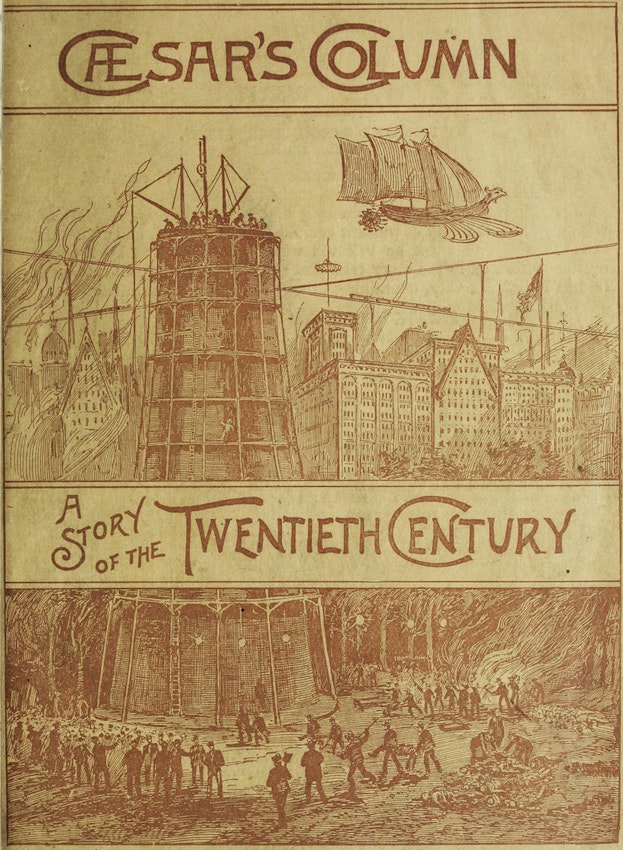 Scroll through the whole page to download all images before printing.
Scroll through the whole page to download all images before printing.Front cover to the 15th edition of Caesar’s Column (1891) — Source.
Caesar’s Column imagined a dystopian United States of 1980 plunged into chaos by the class divisions that so deeply worried contemporary Americans and Europeans. The Haymarket bombing in Chicago in 1886 was fresh in mind when Donnelly sat down to write. So was the upheaval of the Paris Commune, which had already inspired reformer Charles Loring Brace to warn about The Dangerous Classes of New York (1872): “Let the law but lift its hand from them for a season, or let the civilizing influences of American life fail to reach them, and if the opportunity offered, we should see an explosion from this class which might leave this city in ashes and blood.”
Donnelly turned Brace’s fears into fiction. Caesar’s Column was proto–science fiction rather than pseudoscience. It follows the standard utopian/dystopian trope of a visitor from afar who records his experiences and observations. In this case the visitor is Gabriel Weltstein, a wool merchant from the peaceful white society of Uganda who travels to New York by airship and writes a series of letters home. He finds a technologically advanced city with subways under glass, televised newspapers, and unlimited electricity tapped from the aurora borealis. He also finds a city deeply riven by class divides. Through accident, he falls under the guidance of Max Pelton, one of the members of the Brotherhood of Destruction, who shows him the immense inequality engendered by the oligarchy that rules the United States.
Jack London, writing a few years later and with a grasp of socialist theory, would posit a sophisticated resistance movement in The Iron Heel (1908), with a clear ideology and roots in organized labor — even if it falls short of its goals. Donnelly’s revolutionaries are a degraded lumpenproletariat, visceral rather than intellectual, a mob bent on destruction. Caesar Lomellini, the leader of the Brotherhood, is half Italian and half African American, telling ethnic markers that connoted animal instinct rather than reason in contemporary racist thought. His revolution destroys the oligarchs but sheds rivers of blood and plunges the city of ten million into fiery chaos. Faced with the problem of disposing of tens of thousands of bodies, Lomellini has an inspiration:
“Burn em up,” said Caesar.
“We can’t,” said the man; “we would have to burn up the city to destroy them in that way; there are too many of them; and it would be an immense task to bury them.”
“Heap em all up in one big pile,” said Caesar.
“That wouldn’t do — the smell they would make in decaying would be unbearable, to say nothing of the sickness they would create.”
Caesar was standing unsteadily, looking at us with lackluster eyes. Suddenly an idea seemed to dawn in his monstrous head — an idea as monstrous and uncouth as the head itself. His eyes lighted up.
“I have it!” he shouted. “By G-d, I have it! Make a pyramid of them, and pour cement over them, and let it stand forever as a monument of this day’s glorious work! Hoorrah!”
As New York plunges into the fires of revolutionary destruction, Weltstein escapes in an airship to the highlands of Uganda, where white men and women have another opportunity to build a simpler and more equitable society — Donnelly’s effort to reimagine the hopeful white settlement of early Minnesota.
Caesar’s Column was the high point of Donnelly’s career. He continued to write for another decade, turning to parables and political tracts that found few readers. He ran for vice president in 1900 on a ticket splintered from the waning Populist Party — getting one vote out of every three hundred.
With his facile pen and taste for the extreme, a reincarnated Ignatius Donnelly would flourish today as an internet blogger. He would be quick to spin calamities into conspiracies and tweet dire predictions about national collapse and global chaos. Perhaps fortunately for us, he remains stuck in the nineteenth century, a man who had to make do with pen, paper, and his own imagination of disaster.
Carl Abbott is the author of several books about the overlapping topics of the American West, the history of American cities, and science fiction, the most recent being Imagining Urban Futures: Cities in Science Fiction and What We Might Learn from Them (Wesleyan University Press, 2016). His shorter writing has appeared in the Los Angeles Review of Books and Atlantic CityLab. His sporadically updated website is www.theurbanwest.com.







